Click here to go back to the Home Page.
Click here to go back to the Study Page.
Confessions of a Problem Solver
![]() She hung up and I set out the chess board. I filled a pipe, paraded the chessmen and inspected them for French shaves and loose buttons, and played a championship tournament game between Gortchakoff and Meninkin, seventy-two moves to a draw, a prize specimen of the irresistible force meeting the immovable object, a battle without armour, a war without blood, and as elaborate a waste of human intelligence as you could find anywhere outside an advertising agency.
She hung up and I set out the chess board. I filled a pipe, paraded the chessmen and inspected them for French shaves and loose buttons, and played a championship tournament game between Gortchakoff and Meninkin, seventy-two moves to a draw, a prize specimen of the irresistible force meeting the immovable object, a battle without armour, a war without blood, and as elaborate a waste of human intelligence as you could find anywhere outside an advertising agency.
Raymond Chandler, The Long Goodbye.
One of my favorite quotes. I've had to create this new page as a kind of supplement to the Study Page otherwise, because of the diagrams, the download time would be too great.
These are some problems I have attempted quite recently. Of course they should be solved entirely in the mind; without recourse to moving any pieces. Just like a real game!
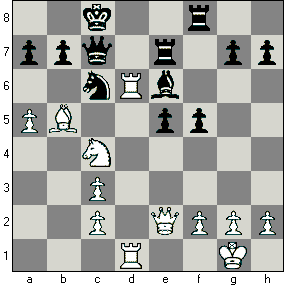
Here Black played 1...Bc4 2.Qc4 Na5 was this correct?
This is fairly easy to work-out. Black has sacrificed the position to win material. After 1...Bc4 2.Qc4 Na5 the first thing to notice (which obviously Black didn't) is that the Black Queen on c7 is pinned by the White Queen on c4 and, also note that square d8 is now not covered any longer by the Knight and that suggests a tactical opportunity for White based on the White Queen invading at square g8. So: 3.Rd8+ Rd8 4.Rd8+ Kd8. Now White can deliver the decisive 5.Qg8+ when Black's King has no escape squares, so 5...Re8 6.Qe8++. [Juarez-Sanguinetti, Rio Hondo 1950]. Correct.

Black to play. What's the best move?
This is more tricky. An obvious try is 1...d3. Is this playable. Well it's clear that White can't take the pawn by 2.Qd3 because after 2...Qd3 3.ed3 Nd2 he loses a piece. Another thing to notice is that after the pawn advance 1...d3 square d4 is available for Black's c6 Knight. So if White plays 2.ed3 (instead of 2.Qd3) Black has 2...Nd4 attacking the Black Queen on c2 which has to move but at the same time it needs to continue to cover the Bishop on d2. So, say the Queen moves to 3.Qd1. Now notice that the Black Knight on d4 can check on f3 (which is no longer covered by the pawn on e2 after 2.ed3. This suggests the final winning tactic. 3...Nd2 and now if White recaptures by 4.Qd2 Nf3+ forks King and Queen. After 5.Kh1 Nd2 White is faced with ruinous material loss. [Demetriescu-Nagy, corr. 1936]. Correct.
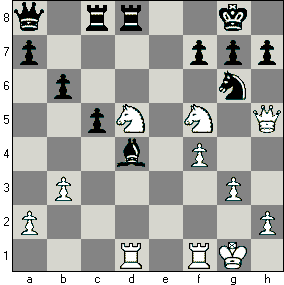
With his last move Black gave a bishop check, intending to reply to 1.Nd4 with Rd5. What's the solution?
Is there anything better than 1.Nd4? Well I found an interesting tactic quite quickly: instead of 1.Nd4, what about 1.Rd4? Then if 1...cd4 [notice that if 1...Rd5? 2.Rd5 Qd5 White has the discovered attack 3.Nh6+] Now White has the tactic 2.Nf6+! gf6 3.Qh6 threatening mate on g7. So Black is forced to move his King instead. If 2...Kf8 [2...Kh8 3.Qh7++] Now it gets more difficult to visualize. Can White ignore his attacked knight on f6 and play 3.Qh7 threatening 4.Qg8++? What happens after 3...gf6 I think this looks quite promising for White. Then I noticed that if 4.R(either)e1 White threatens 5.Qg7++. Can Black defend? I don't see how. Lets recap: 1.Rd4 cd4 2.Nf6+ Kf8 3.Qh7 now 3...gf6 4.Re1 and Black gets mated by Qg7. O.K. can Black improve? He doesn't take the Knight by 3...gf6. But how does he then prevent the mate on g7? I couldn't see how Black can defend. [Dus Chotimirsky-Bannik, Vilnius 1944]. Correct.
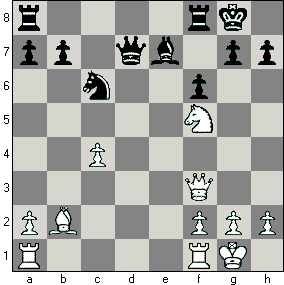
1...Ne5 was played? What is your reply?
First of all I looked at 2.Be5 but after 3.fe5 the White Knight is pinned and White's position doesn't look particularly appealing. What about 2.Ne7+ Qe7. Doesn't look promising either. Than I tried 2.Qd5+ that was it! Black can capture 2...Qd5 because 3.Ne7+ and 4.Nd5 wins material. If 2...Kh8 3.Qd7 Nd7 4.Ne7 and again White wins material. So Black has to play 2...Rf7. What does White do now? 3.Qd7 Nd7 4.Ne7 Re7 leads to nothing. Likewise 3.Ne7 Qe7 or 3.Be5 Qd5 4.cd5 fe5. Maybe 2.Qd5+ isn't right after all. Had I had missed an 'in between' move? 3.Be5 Qd5 and now not the immediate recapture 4.cd5 but 4...Ne7+ first and after 5.Re7 cd5 but it isn't decisive. I checked the diagram again just to make sure that I hadn't made a mistake with the position - I hadn't! Than something else occurred to me after 1...Ne5 2.Qd5+ Rf7, what about 3.f4 instead of 3.Be5? If the attacked Knight moves obviously Black's Queen drops, so: 3...Qd5 and now 4.Ne7+ Rf7 5.cd5 Nc4. No that doesn't look right either. It was then that suddenly I saw the correct solution - and it was ridiculously simple. 2.Be5 fe5 3.Qd5+ now! and after 3...Qd5 4.Ne7+ wins a piece!! I felt rather embarrassed by this. How had I failed to miss it? I had studied this position for at least 10 minutes had found Qd5+ but had only now realized that I should play it on move three rather than move two - stupid!! [Miles-Timman, Amsterdam 1985]. It's ironic that in the previous position, which was much more difficult I found the answer in under sixty seconds (not including checking the variations) but in the much simpler position above it took me so long to find something really quite simple. This only counts as a partial success.
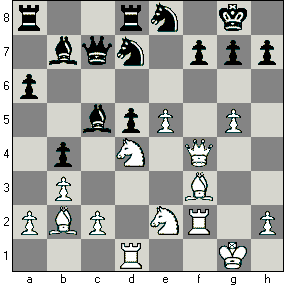
White to play. No hints!
One's eye is immediately drawn to the undefended square f7. Try 1.Qf7+ Kf7 2.Bd5 dis+ It's also double check so the King has to move 2...Ke7 3.Rf7++ or 2...Kg6 3.Bf7+ Kg5 (forced) 4.Bc1+ 4...Kg4 (forced) 5.Rg2+ Kh4 6.Bg5+ Kh3 7.Be6++. Now you should be able to see some blemishes here!! When I rechecked this I suddenly realized that square g2 is covered by Black's Bishop on b7!! I had forgotten that the Black pawn on d5 was no longer there. This is one of the biggest problems when it comes to going through sequences of moves in your head; you forget that pawns and pieces no longer occupy certain squares! There also some other inaccuracies. Even if 5.Rg2+ were playable the rest of the line hasn't been correctly visualized in my mind either. For one thing 4.Kg4 isn't forced. I had failed to notice that the Black King can also go to h4. It's true that if 5.Rg2+ were possible the position of the Black King is so precarious that there is almost bound to be something decisive for White. Anyway, these other mistakes are academic; 5.Rg2+ isn't on. So try again! Fortunately I quickly discovered that after 4.Bc1+ Kg4 White can play 5.Rf4+ (instead of 5.Rg2+?). Now if 5...Kh3 I saw 6.Rd3++. In this line if instead 4...Kh4 5.Rf4+ Kh3 6.Rd3++ also. What about 5...Kg5? I struggled with this until I finally realized that a simple side-step with the Rook mates: 6.Re4++ although this requires a little effort to visualize that there are no escape squares left for Black's King. It's just a question of being careful and trying not to miss anything really big. In a position like this the undefended point f7 is a dead give away so 1.Qf7+ isn't that difficult to spot. That isn't the problem; what is, is working out the rest of the sequence and remembering to take into account that as you move along it (it helps that virtually all of it is forced) pieces and pawns disappear. Files and diagonals come open. Forgetting that there is no longer a pawn on d5 (after 2.Bd5+) and then playing the Rook to g2 in your mind is a very typical mistake. Also what would happen if I had had this position over the board and was in desperate time trouble? [Rodl-Blumich, Wiesbaden 1934] Correct.
I'll give myself a score of 4.5 out of 5 for these. Three correct, one 90% correct, and one partial success..
The above problems come from Your Move! by Yakov Neishtadt published by Batsford.
The above exercises represent good practice at sharpening up a player's tactical game but these kinds of problems I think are, in some respects, unsatisfactory. For example, in actual games no-one taps you on the shoulder and whispers to you 'now there's a nice combination', or 'you can now win in a few moves'. Would I have found the above solutions by myself if I hadn't already 'been told' in advance that there was something decisive in the position? As well as this objection in real games gaining the upper hand over one's opponent is seldom a question of finding a nice combination that wins material or forces him to resign in a few moves. Often it is a question of finding a move, or conceiving a plan which may take, say, four to five moves maybe more to gain a significant, but not necessarily decisive, advantage.
The following problems come from Mark Dvoretsky's Training for the Tournament Player. In my opinion a really exceptional piece of work.

All I knew about the above position (it can be found on page 39) is that it had occurred in the game of a famous grandmaster. The grandmaster concerned (who is playing White) had not chosen the strongest continuation. It is White to move. My thoughts: I'll do a 'body count'. Material is level. I would say that White is better. Both sides have isolated d-pawns but White's minor pieces have greater possibilities than Black's. In particular the White Knight on square d4 could land on e6 at some point. Black's Knight, on the other hand, has no such nice squares and at f7 isn't at all well placed. The White Rook on f1 is attacked. Should I simply move it? Uhm...well I could but I would like to take advantage of e6 and play something a little more adventurous than just moving my Rook. Also, bearing in mind that I know the Grandmaster in question didn't find the best continuation it's a fair assumption that he just moved his attacked Rook. If I could play 1.Ng5-e6 it would be quite pleasant for me. Now I have to calculate; what happens after 1.Ng5? If Black takes my Rook on f1: 1...Bf1 what I do I do now? 2.Nge6+ Kg8 (I also have to consider also the possibility that Black may return the exchange by 2...Re6 3.Ne6+ Kg8 but than I can recapture by 4.Rf1and my nice Knight must give me a better game). So, after 2...Kg8 what next?
I'm an exchange down; have I got any positional compensation? Well, I'm certainly not going to win the game in a few moves. It's true my Knights are effective but an exchange is still an exchange. I decide that this isn't the best way to play and I return to the starting position. A thought occurs to me: if I could play my Queen to c3 I would have a discovered check by moving my d4 Knight. Trouble is that I obviously can't play this - I would just lose my Queen! But what happens after 1.b3!? Bf1 2.Qb2? (even 2.Ne6+ first but I think that 2.Qb2 is better) Very interesting! I'm an exchange down. Do I have threats? Well, of course! I'm threatening 3.Ne6 double check and Qg7 uhm very nice! The Black King moves, say, 2...Kg8 then 3.Ne6 threatens mate on g7 so Black takes: 3...Re6 and after 4.de6 his Knight on f7 is attacked and, of course, I can still take the Bishop on f1. This is quite an interesting line: 1.b3 Bf1 2.Qb2 Kg8 3.Ne6 Re6 4. de6 Bc4 (I notice this is possible because I can't take the Bishop because I would lose my Queen) 5.ef7+ Kf7. Who's better? Body count: I've lost a Rook, a Knight and a pawn and Black has lost a Rook and a Knight; so effectively I have saced a pawn (my d-pawn). What about the position. I have a check: 6.Ng5+ when Black has to be careful because my Queen on b2 can go to f6, so 6...Kg8 and if now 7.Qf6 threatening mate in two, Black defends by 7...Rc7.
I check the main line again: 1.b3 Bf1 2.Qb2 Kg8 3.Ne6 Re6 4.de6 Bc4 5.ef7+ Kf7 6.Ng5+ Kg8 7.Qf6 Rc7. I check it again and again. I then notice my Rook on e1 (I've forgotten it!) can go to e7, so 8.Re7. At first I think I've made a mistake My Rook on e1 is undefended - it's attacked by Black's Rook on e8. No it isn't that Rook no longer exists (3...Re6 remember)! I also realize that in fact after 7.Qf6 I'm not threatening mate since Black's Bishop on c4 covers square f7. Also something else: I've missed that after 6...Kg8 I can play my other Knight to e6. After 7.Ne6 again the threat of mate on g7 is renewed! So the line now is 1.b3 Bf1 2.Qb2 Kg8 3.Ne6 Re6 4.de6 Bc4 5.ef7+ Kf7 6.Ng5+ Kg8 6.Ne6. All this calculation is time consuming and I have never been the fastest of players. What if Black doesn't capture my Rook on f1 by the way? 1.b3 Kg8 instead? But then I have 2.Nf6+ Now I realize I can play this in the main line (why didn't I see it?). 1.b3 Bf1 2.Qb2 Kg8 3.Nf6+ (instead of 3.Ne6). So in the main line the Black King should, perhaps, retreat to f8 (instead of g8). So the amended main line is: 1.b3 Bf1 2.Qb2 Kf8 3.Ne6+ (this is now a check) 3...Re6 (surely still forced) 4.de6 Bc4 5.ef7 (now this isn't with check) 5...Bf7 (this is a new move I've just spotted - I forgot the bishop can recapture on f7)
Well, all this is rather complicated but it does show at least that there is something worth looking at. After 1.b3 if Black simply retreats the Bishop to, say, d7 incidentally I can still play 2.Qb2 and I've lost nothing. So, the main line is now: 1.b3 Bf1 2.Qb2 Kf8 3.Ne6+ Re6 4.de6 Bc4 5.ef7 Bf7 6.Ng5. I'm not sure maybe I have something better here. The position is unclear (this is what they all say isn't it?) I've saced a pawn (my d-pawn) and, incidentally, my opponent now has a passed d-pawn. This is about as much analysis as I can do. I'm left with the feeling that 1.b3 is an interesting move and although it's difficult to assess the outcome with complete confidence I think in a real game I would almost certainly play it. Of course this process seems on the face of it rather chaotic and disorganized. The constant tooing and frowing. A line is found, you play it through in your mind several times and perhaps each time you find a move you didn't 'see' previously. I remember something that Alexander Kotov said in his book Think Like a Grandmaster; something about candidate moves and the tree of analysis. Well, it's fine in theory but in a real situation it's just not that easy. The above isn't that difficult in the sense that there is one main line and as you follow it there are only a few alternative moves to consider for Black. This is, at least, my feeling. I have yet to actually see Dvoretsky's solution and there are, no doubt, moves that I have missed. It could be, of course, that I am completely mistaken about 1.b3!
Click here for an article on thinking in chess.
Dvoretsky's solution [page 183]
The game turned out to be Botwinnik-Suttles, Belgrade 1969. The tempting 25.f5? is a mistake, in view of 25...Re4! In the game there followed 25.Rf3? Rc4 26.Rd3, and now instead of 26...Qb4?! 27.b3 Qd2 28.Rd2 Qc7 29.Rde2 Black could have equalized completely with 26...Bf5! 27.Nf5+ gf5 28.Rb3 Qc7. But White missed a winning line (pointed out by Tringov):
25.b3!! Bf1 26.Qb2 Kf8 27.Ne6+ Re6 28.de6...Botwinnik himself [wrote]...'my old "illness" - weak combinational vision - was to blame'.
I had not even considered 25.f5. I was, however, completely vindicated regarding 25.b3. As always you have an advantage over the player actually playing the game - you're told that there is something hidden in the position and so you're faculties are sharpened - you start searching for something. Would I have found 25.b3 in a real game? I don't know for sure. The obvious course of action was just to move the attacked Rook. Partly it depends on how much time I had and partly on mood and other mysterious psychological factors no-one really understands. Maybe I would - who knows.
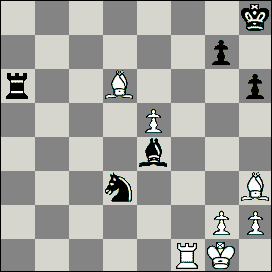
The above position can be found on page 65 from the same book. I know nothing about the players. All I do know is that it is White to play. In terms of material White is a pawn up; he has two bishops and most importantly a dangerous passed pawn on e5. The first thing I did was try the pawn advance e6; after 1.e6 Rd6 2.e7 and the e-pawn can be stopped by either 2...Bc6 or 2...Bg6. Than I noticed that after 2...Bg6 3.Rf8+ Kh7 4.Bf5 pins Black's Bishop and threatens 5.e7=Q. I concluded that Black should respond to 2.e7 by 2...Bc6 instead. So now the main line is: 1.e6 Rd6 2.e7 Bc6. So what next? Remember that I am now a piece down so I have to find something fairly decisive. I can still play the Rook check 3.Rf8+ Kh7 Now if I promote the e-pawn by 4.e8=Q after 4...Be8 5.Re8 I have just lost my d-pawn for nothing. So, there's nothing to be gained by playing that. Then I noticed that I can play 4.Bf5+ g6. Now I was stuck for several minutes, I just went over the sequence in my mind several times: 1.e6 Rd6 2.e7 Bc6 3.Rf8+ Kh7 4.Bf5+ g6. Then I discovered 5.Rc8 which attacks the Bishop on c6 that prevents my e-pawn from promoting. If now 5...gf5 6.Rc6 Re7 [I think this works!]. After 5.Rc8 it gets quite hard to visualize so I had to go over the sequence maybe five or six times: 1.e6 Rd6 2.e7 Bc6 3.Rf8+ Kh7 4.Bf5+ g6 5.Rc8 gf6 6.Rc6. What's the material situation - I have to think hard - I've lost both my bishops and my e-pawn and Black has lost his Bishop! It's easy to forget about the body count as the move sequence gets longer and longer! In this line I had sacrificed material for what? For nothing! After 1.e6 I either have to find a way of promoting my e-pawn or getting the material back with at least a level position; otherwise why bother? I have a feeling I am missing something so try again: 1.e6 Rd6 2.e7 Bc6 3.Rf8+ Kh7 4.Bf5+ g6. Now, what about 5.Be4? The Bishop can't be taken, of course, because my e-pawn promotes and if it the attacked Bishop goes to 5...Bd7? I can play 6.Rf7+ Kg8 7.Rd7 Rd7 and 8.e8=Q voila! So where does the Black Bishop go? Perhaps 5...Ba4. I go through the new sequence again: 1.e6 Rd6 2.e7 Bc6 3.Rf8+ Kh7 4.Bf5+ g6 5.Be4 Ba4 (say). This is hard work! But I'm still material down and I still can't safely promote my e-pawn. Another possibility is: 1.e6 Rd6 2.e7 Bc6 3.Rf8+ Kh7 4.Bf5+ g6. Now I had an idea; now the King is on h7 if I put my Rook on, say, c7 I could then threaten to promote my e-pawn with a discovered check. But how to achieve it? I mean if I play Rc7 it's a check and not a discovered check!! If I play 5.Rc8 attacking the White Bishop on c6 after 5...gf6 6.Rc7+ Kg8 I have nothing. I can play only 7.Rc6 Re7 not 7...Rc6 8.e8=Q, and I end up a piece down. I run through the main line again; I see nothing decisive. I have a feeling I have missed something. Maybe my first move 1.e6 just isn't right. I tried changing the move order: 1.Rf8+ Kh7 2.Bf5+ Bf5 3.Rf5. I'm still a pawn up, but I'm sure this isn't the answer. I gave up in frustration!!
Dvoretsky's solution [page 183]
The game turned out to be Yusupov-Timman, Reykjavik 1988. White could have won by force. 1.Re6! Rd6 2.e7 Bc6 3.Rf8+ Kh7 4.Bf5+! g6 5.Rd8 Rf6 6.Bd7 Bd7 7.Rd7. [Yusupov] overlooked the intermediate check 4.Bf5+ and chose 1.g3? Kh7 2.Bg2 Bg2 3.Kg2 Kg6 4.Rf8, but Timman found a defence: 4...Nb2!, after which it turned out to be impossible to convert [his] extra pawn into victory.
Well, I was right about 1.e6 and had seen 4.Bf5+ g6 but missed the idea of 5.Rd8, only finding 5.Rc8 and 5.Be4. I played through the position. Surprisingly the idea of playing 5.Rd8 never once even occurred to me!! Of course once you're able to actually move the pieces everything seems clear. After 5...Rf6 6.Bd7 Bd7 7.Rd7 of course I saw that my intuition about promoting my e-pawn with discovered check [remember what I said above: But how to achieve it? I mean if I play Rc7 it's a check and not a discovered check!!] had been closer to the truth than I had realized. I had envisioned a position with the White Rook on the seventh rank somewhere, the e-pawn on e7 and the Black King on h7; next move I'm going to play e8=Q dis+. Well, O.K. it's not exactly right is it - but it's also not a million miles away! I think if I had seen 5.Rd8, instead of Rc8 somewhere maybe I would have seen 6.Bd7 too. Perhaps!!
![]()
On May 15, a book will be released. This book has been written by the Polish International Master Jan Przewoznik and Marek Soszynski. You may say: so what? Another book on chess - amazing! The title is, however, a little off the beaten track. It is entitled How to Think in Chess (288pp., $24.95, Russell Enterprises, Inc.). It's subject matter is the thought processes of the modern player and how we might go about improving it. Jan Przewoznik, is a former champion of Poland an International Master and one of his country’s most prolific writers on the game. Marek Soszynski is a philosopher, having specialized in aesthetics at universities in England and Poland. He was a strong player on the British correspondence chess.
The fact that one of the authors is a philosopher should from the outset place the reader on his guard. I studied philosophy at University and well remember being told by one of my lecturers to be especially wary of a Philosopher with a Theory. If you want to get better an essential pre-requisite of this is to know thyself. If you can know thyself - I think what they really mean is know your thinking - or at least have some understanding of how it works and down which particular channels your thought proceeds. How exactly does one solve problems; not just chess problems but any kind of problem. Which part of your thinking is not quite right? Once discovered how do you go about improving it? Know thyself is a principle familiar since the days of Socrates, and its worth is repeatedly proved in many walks of life, the book claims. Is it? This, they claim, necessary self-knowledge is the first indispensable step to improving your thinking and problem solving skills. They make the dubious assertion that unless you know where you are, and where you want to go, progress is impossible. You might think it strange that more books on chess thinking aren't written. After all if there is a characteristic that unites all chess players it is the fact they think! But what help is that? What form of human activity doesn't require thinking of some kind? That is the problem. Thinking is such a ubiquitous activity that it's hard to pin it down. Someone once wrote that if we could understand the notion of thinking human beings would be so stupid that they would capable of only the simplest things and Chess would not be one of them! Thinking is often such a ramshackle, disorganized affair as to defy analysis. Also, thinking requires a context and that context will determine the way one's thinking proceeds and is organized; thinking about chess is going to be a markedly different kind of activity from thinking about, say cooking one's next meal. Thinking can be so difficult to 'get at'. I know from my own experience after a game if I ask myself the question what and how I was thinking during the course of a game it can be notoriously difficult to reconstruct.
The book draws heavily on the research of the Dutch psychologist and chess player, Adriaan de Groot. Around the time of the famous AVRO tournament in 1938, and later, he interviewed several of the world’s top players including Alexander Alekhine, Max Euwe, Reuben Fine, Salo Flohr, Paul Keres, and Saviely Tartakower. They were subjected to various chess tests and he then compared their responses and results with those of weaker players, two female Dutch champions. He wanted to know about calculation. The calculation of variations. I'm sure there are many club players who believe that it is in the area of calculation that separates most keenly players of their standard from top titled players. What he discovered surprised him. Generally speaking the top players didn't calculate any deeper than the weaker players. He did discover, however, something that wouldn't surprise most of us: The Grandmasters were able to memorize positions from similar games very much better than the weaker players. They also seemed to have at their disposal a huge internal store of 'templates' which assisted them in solving the problems over the board and finding the right moves. De Groot called these things 'chunks' De Groot concluded that the top players didn't analyze more or longer variations than the others but they did rely a lot on these 'chunks'. Well, there you are then, the best way to improve your game is just get hold of these chunks - the more chunks you have the better!! The authors cite the following two games:Najdorf–Pilz, Warsaw, 1934
1.d4 Nf6 2.c4 e6 3.Nc3 Bb4 4.Qc2 c5 5.dc5 Bc5 6.Nf3 d5 7.Bg5 dc4 8.e3 0-0 9.Bc4 Nbd7 10.0-0 h6 11.Bh4 Qa5 12.a3 Be7 13.b4 Qb6 14.Rfd1 a5 15.Rab1 ab4 16.ab4 Kh8 17.Nb5 Nb8 18.Bg3 Na6 19.Bd6 Ng8 20.Ne5 g6 21.Be7 Ne7 22.Rd6 Nc6 23.Ng6+ fg6 24.Qg6 Nab4 25.Qh6+ Kg8 26.Re6 Be6 27.Be6+ Rf7 28.Qg6+ Kh8 29.Bf7 1-0.
This game was awarded the first brilliancy prize. This is what Najdorf said about it: ...I can remember at no time seeing more than two moves ahead.
Nunn–Tal, Wijk aan Zee, 1982
1.e4 c5 2.Nf3 e6 3.d4 cd4 4.Nd4 Nc6 5.Nc3 a6 6.g3 Qc7 7.Bg2 Nf6 8.0-0 h6 9.Nb3 Be7 10.a4 d6 11.f4 0-0 12.g4 Bd7 13.h4 b5 14.g5 Nh7 15.Be3 b4 16.Ne2 d5 17.ed5 ed5 18.Qd5 Rac8 19.a5 Nb8 20.Ned4 Bg4 21.Rae1 Rfd8 22.Qe4 Re8 23.Bf2 Bd7 24.Qd5 Qd6 25.Nf5 Qd5 26.Ne7+ Re7 27.Bd5 Re1 28.Re1 Rc2 29.Re7 Bc6 30.Bf7+ Kf8 31.Rc7 hg5 32.Bc5+ 1-0.
Nunn wrote after this game that so far as he could remember he hardly calculated a single variation more than a couple of moves deep during the entire game.
There is another important finding by de Groot, which has been confirmed again and again by later researchers. Chess players, including the very best, do not as a rule immediately make a short and neat mental list of candidate moves that they then consider one at a time. This is simply not how people approach most problems, nor is there any reason why they should approach all problems that way.
One author I remembered who was heavily into the idea of calculation being the touchstone of chess mastery and the use of concepts like candidate moves, and the tree of analysis was Alexander Kotov:
Of the many scientific techniques studied at secondary school level and after for clarifying problems a particularly helpful one is the drawing of graphs and diagrams.
This is Kotov's famous tree of analysis approach to calculating variations and analysis in general. Later on he exhorts us to be self disciplined in its use:
In analyzing complicated variations one must examine each branch of the tree once and once only. You simply must not wander to and fro, here and there throughout the branches, losing time in checking. The reason for such checks can only be lack of confidence in oneself. Better to suffer the consequences of an oversight than suffer from foolish and panicky disorder in analysis.
I remember when I first read this some years ago how well intentioned but implausible the whole seemed to be. Were top ranking chess masters really so intellectually well organized and rigorous as Kotov implied? De Groot's findings seem on the face of it to run counter to Kotov's approach. It may be, of course, that this is the method Kotov himself used and so it would have been natural for him to encourage others to adopt it.
De Groot’s studies were not widely discussed in the literature of either chess or psychology, but this seminal work deserves wider attention among chess players and psychologists interested in research into cognitive processes. The authors discuss the notion of what they call 'thinking aloud'. I think they mean this in a metaphorical sense - they don't mean, of course, speaking aloud during the course of a game! I think this is a good idea and is something I try to foster in my own games. If one can promote the habit of having an internal dialogue with one's self during the course of a game this, I think, must surely have a favorable effect on one's results. It appears that the method of thinking aloud, although time-consuming and hard to carry out, can serve as a valuable complement to chess training.
The authors now discuss some methods that chess players could take up to improve their thinking during the course of battle. The method of thinking aloud can develop in the chess player a habit of efficient organized thought. Particularly at critical moments in a game the player can initiate a fixed procedure of thought The player can learn to become more methodical during play. The authors are keen to point out that none of this will undermine creativity Using certain patterns of organized thinking does not at all curb creativity – quite the opposite. Skillfully put to good use, it can foster the discovery of original ideas. Look at the following three positions:

White could just queen with check, but in place of that there is 1.Kf6! Kh7 2.f8=R Kh6 3.Rh8#. This is not just being "flashy," it is actually the quickest way to win.
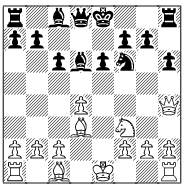
A certain line of the solid, "boring" Caro-Kann Defense was known to theory: 1.e4 c6 2.d4 d5 3.Nd2 dxe4 4.Nxe4 Nd7 5.Ng5 Ngf6 6.Bd3 e6 7.N1f3 Bd6 8.Qe2 h6 9.Ne4 Nxe4 10.Qxe4 Nf6 11.Qh4. Surely nothing out of the ordinary could happen here, as early as this? Since 11...0-0? is answered by 12.Bxh6 gxh6 13.Qxh6 followed by g2-g4-g5, Black has to content himself with the mundane 11...Qc7, or 11...Qa5+ 12.Bd2 Qh5. Or so it had been thought. And then in one game Anatoly Karpov came up with 11...Ke7!?, which threatens …g7-g5 embarrassing the white queen (Kamsky–Karpov, Dortmund, 1993).
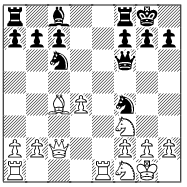
Next, a case of what we are stressing throughout – seek and ye shall find. Black to
move. At first glance White’s kingside formation appears somewhat vulnerable to a piece sacrifice on h3, but we imagine that Adolf Anderssen looked again to find something far stronger. 1...Nxg2!! 2.Kxg2 Qxf3+! 3.Kg1 Nxd4 4.Qe4 b5? A pity. This also required a second look because it allows 5.Bd5 Qxe4 6.Rxe4 when White would soon be only one pawn down. 5.Bd3? f5 6.Qxd4 Bb7 0-1 (Saalbach–Anderssen, Leipzig, 1858).I'm rather unsure as to what to make of this book. I don't think I can unreservedly recommend it. It certainly contains much which is thought provoking; and that in itself is an all to rare virtue in many chess books these days. It certainly won't make you a poorer player. The question is will it make you a stronger one? There is a lot of waffling to be found in it's page and much which is unnecessarily obscure and long-winded. Thinking in chess is something, however, that should be taken more seriously. As the Philosopher, Bertrand Russell put it:
![]() "Do not discourage thinking for you are bound to succeed!"
"Do not discourage thinking for you are bound to succeed!"

How to Think in Chess is scheduled for release May 15, 2001. It will have a suggested retail price of $24.95. For
ChessCafe.com readers, it may be ordered until May 15 for $17.95. You should expect delivery of How to Think in Chess by the end of May.Click here to go to Chess Cafe to order.
Although I've tried my best to eliminate any errors on this page if you find any I would appreciate it if you could send me an email about it at felixstowechess@lycos.com.
Click here to go back to the Home Page.
Click here to go back to the Study Page.
Click here to go the top of this Page